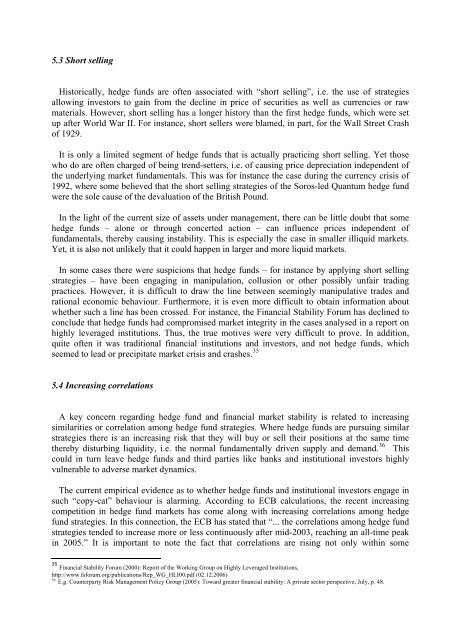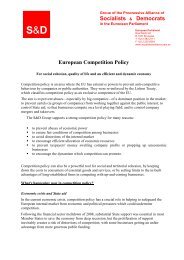Executive summary - Udo Bullmann
Executive summary - Udo Bullmann
Executive summary - Udo Bullmann
- No tags were found...
You also want an ePaper? Increase the reach of your titles
YUMPU automatically turns print PDFs into web optimized ePapers that Google loves.
5.3 Short sellingHistorically, hedge funds are often associated with “short selling”, i.e. the use of strategiesallowing investors to gain from the decline in price of securities as well as currencies or rawmaterials. However, short selling has a longer history than the first hedge funds, which were setup after World War II. For instance, short sellers were blamed, in part, for the Wall Street Crashof 1929.It is only a limited segment of hedge funds that is actually practicing short selling. Yet thosewho do are often charged of being trend-setters, i.e. of causing price depreciation independent ofthe underlying market fundamentals. This was for instance the case during the currency crisis of1992, where some believed that the short selling strategies of the Soros-led Quantum hedge fundwere the sole cause of the devaluation of the British Pound.In the light of the current size of assets under management, there can be little doubt that somehedge funds – alone or through concerted action – can influence prices independent offundamentals, thereby causing instability. This is especially the case in smaller illiquid markets.Yet, it is also not unlikely that it could happen in larger and more liquid markets.In some cases there were suspicions that hedge funds – for instance by applying short sellingstrategies – have been engaging in manipulation, collusion or other possibly unfair tradingpractices. However, it is difficult to draw the line between seemingly manipulative trades andrational economic behaviour. Furthermore, it is even more difficult to obtain information aboutwhether such a line has been crossed. For instance, the Financial Stability Forum has declined toconclude that hedge funds had compromised market integrity in the cases analysed in a report onhighly leveraged institutions. Thus, the true motives were very difficult to prove. In addition,quite often it was traditional financial institutions and investors, and not hedge funds, whichseemed to lead or precipitate market crisis and crashes. 355.4 Increasing correlationsA key concern regarding hedge fund and financial market stability is related to increasingsimilarities or correlation among hedge fund strategies. Where hedge funds are pursuing similarstrategies there is an increasing risk that they will buy or sell their positions at the same timethereby disturbing liquidity, i.e. the normal fundamentally driven supply and demand. 36 Thiscould in turn leave hedge funds and third parties like banks and institutional investors highlyvulnerable to adverse market dynamics.The current empirical evidence as to whether hedge funds and institutional investors engage insuch “copy-cat” behaviour is alarming. According to ECB calculations, the recent increasingcompetition in hedge fund markets has come along with increasing correlations among hedgefund strategies. In this connection, the ECB has stated that “... the correlations among hedge fundstrategies tended to increase more or less continuously after mid-2003, reaching an all-time peakin 2005.” It is important to note the fact that correlations are rising not only within some35 Financial Stability Forum (2000): Report of the Working Group on Highly Leveraged Institutions,http://www.fsforum.org/publications/Rep_WG_HLI00.pdf (02.12.2006)36E.g. Counterparty Risk Management Policy Group (2005): Toward greater financial stability: A private sector perspective, July, p. 48.





